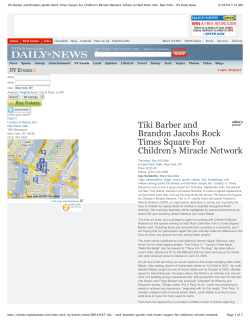
Document 156599
Igneous Rocks Discover Read i n9 Focus Activity Key Concepts • What characteristics are used to classify igneous rocks? • How are igneous rocks used? Key Terms • extrusive rock • intrusive rock Target Reading Skill Identifying Main Ideas As you read Classifying Igneous Rocks, write the main idea in a graphic organizer like the one below. Then write three supporting details that further explain the main idea. Main Idea Igneous rocks are classified by origin, texture, and composition. Deiail De~ail De~ail How Do Igneous Rocks Form? 1. Use a hand lens to examine samples of granite and obsidian. 2. Describe the texture of both rocks using the Obsidian terms coarse, fine, or glassy. 3. Which rock has coarse-grained crystals? Which rock has no crystals or grains? Think It Over Inferring Granite and obsidian are igneous rocks. From your observations, what can you infer about how each type of rock formed? Granite The time is 4.6 billion years ago. You are in a spacecraft orbit ing Earth. Do you see the blue and green globe of Earth that astronauts today see from space? No-instead, Earth looks like a charred and bubbling marshmallow heated over hot coals. Soon after Earth formed, the planet's interior became so hot that magma formed. Lava repeatedly flowed over the sur face. The lava quickly hardened, forming a rocky crust. Because this early crust was denser than the material beneath it, chunks of crust sank into Earth's interior. This allowed more lava to erupt over the surface and harden to form rock. DOD Classifying Igneous Rocks The first rocks to form on Earth probably looked like the igne ous rocks that can be seen today. Igneous rock is any rock that forms from magma or lava. The name igneous comes from the Latin word ignis, meaning "fire." Igneous rocks are classified according to their origin, texture, and mineral composition. eGo nline scz· C-"""'N=STA"--:::> INKS,. For: Links on igneous rocks Visit: www.SciLinks.org Web Code: scn-1052 148 • F Origin Igneous rock may form on or beneath Earth's surface. Extrusive rock is igneous rock formed from lava that erupted onto Earth's surface. Basalt is the most common extrusive rock. Basalt forms much of the crust, including the oceanic crust, shield volcanoes, and lava plateaus. oueru Igneous rock that formed when magma hardened beneath Earth's surface is called intrusive rock. The most abundant intrusive rock in continental crust is granite. Batholiths made of granite form the core of many mountain ranges. Texture The texture of an igneous rock depends on the size and shape of its mineral crystals. The only exceptions to this rule are the different types of volcanic glass-igneous rock that lacks a crystal structure. Igneous rocks may be similar in mineral composition and yet have very different textures. Rapidly cooling lava forms fine grained igneous rocks with small crystals. Slowly cooling magma forms coarse-grained rocks with large crystals. Therefore, intru sive and extrusive rocks usually have different textures. Intrusive rocks have larger crystals than extrusive rocks. If you examine a coarse-grained rock such as granite, you can easily see that the crystals vary in size and color. Some intrusive rocks, like the porphyry in Figure 6, have a texture that looks like a gelatin dessert with chopped-up fruit mixed in. Extrusive rocks have a fine-grained or glassy texture. Basalt is a fine-grained extrusive rock. It consists of crystals too small to be seen without a microscope. Obsidian is an extrusive rock that cooled very rapidly without forming crystals. As a result, obsidian has the smooth, shiny texture of a thick piece of glass. OO[ Rocks Video Preview Field Trip Video Assessment ~ Video FIGURE 6 Igneous Rock Textures Igneous rocks such as rhyolite, pegmatite, and porphyry can vary greatly in texture depending on whether they are intrusive or extrusive. Relating Cause and Effect What conditions caused rhyolite to have a fine-grained texture? Rhyolite A fine-grained, extrusive igneous rock with a mineral composition similar to granite Pegmatite A very coarse-grained, intrusive igneous rock Porphyry An intrusive igneous rock with large crystals surrounded by small crystals; forms when magma cools slowly at first, then rapidly F • 149 Mineral Mixture Granite is a mixture of light-colored minerals such as feldspar and quartz and dark-colored minerals including hornblende and mica. But, granite can vary in mineral composition, affecting its color and texture. Study the circle graph and then answer the questions. 1. Reading Graphs What mineral is most abundant in granite? 2. Reading Graphs About what percentage of granite is made up of dark minerals? 3. Calculating If the amount of quartz increases to 35 percent and the amount of dark-colored minerals stays the same, what percentage of the granite will be made up of feldspar? Dark minerals (mica, hornblende) 4. Predicting How would the color of the granite change if it contained less feldspar and more mica and hornblende? Mineral Composition You may recall that the silica con tent of magma and lava can vary. Lava that is low in silica usu ally forms dark-colored rocks such as basalt. Basalt contains feldspar as well as certain dark-colored minerals, but does not contain quartz. Magma that is high in silica usually forms light-colored rocks, such as granite. Granite's mineral composition deter mines its color-light gray, red, pink, or nearly black. Granite that is rich in reddish feldspar is a speckled pink. But granite rich in hornblende and dark mica is light gray with dark specks. Quartz crystals in granite add light gray or smoky specks. Geologists can make thin slices of a rock, such as the gabbro in Figure 7. They study the rock's crystals under a microscope to determine the rock's mineral composition. ~~~~~~int How can mineral composition affect a rock's color? 7 Thin Section of a Rock This thin slice of gabbro, viewed under a microscope, contains olivine, feldspar, and other minerals. FIGURE Uses of Igneous Rocks Many igneous rocks are hard, dense, and durable. People throughout history have used igneous rock for tools and building materials. Building Materials Granite has a long history as a building material. More than 3,500 years ago, the ancient Egyptians used granite for statues like the ones shown in Figure 8. About 600 years ago, the Incas of Peru carefully fitted together great blocks of granite and other igneous rocks to build a fortress near Cuzco, their capital city. In the United States during the 1800s and early 1900s, granite was widely used to build bridges and public buildings and for paving streets with cobblestones. Today, thin, polished sheets of granite are used in curbstones, floors, and kitchen counters. Basalt is crushed to make gravel that is used in construction. Other Uses Igneous rocks such as pumice and obsidian also have important uses. The rough surface of pumice makes it a good abrasive for cleaning and polishing. Ancient native Amer icans used obsidian to make sharp tools for cutting and scrap ing. Perlite, formed from the heating of obsidian, is often mixed with soil for starting vegetable seeds. What igneous rock is most often used as a building material? FIGURE 8 Durable Granite The ancient Egyptians valued granite for its durability. These statues from a temple in Luxor, Egypt, were carved in granite. - Section 2 ASsessment I Target Reading Skill Identifying Main Ideas Use your graphic organizer about the cha.racteristics of igneous rock to help you answer Question 1 below. Reviewing Key Concepts 1. a. Explaining How are igneous rocks classified? b. Defining What are extrusive rocks and intrusive rocks? c. Comparing and Contrasting Compare granite and basalt in terms of their origin and texture. Which is extrusive? Which is intrusive? 2. a. Summarizing What are two common uses of igneous rocks? b. Reviewing What characteristics make igneous rocks useful? c. Making Judgments Would pumice be a good material to use to make a floor? Explain. rLab ~ lone At-Home Activity The Rocks Around Us Many common household products contain minerals found in igneous rock. For example, glass contains quartz, which is found in granite. Research one of the following materials and the products in which it is used: garnet, granite, perlite, pumice, or vermiculite. Explain to family members how the rock or mineral formed and how it is used. Chapter 5 F • 151
© Copyright 2025


















